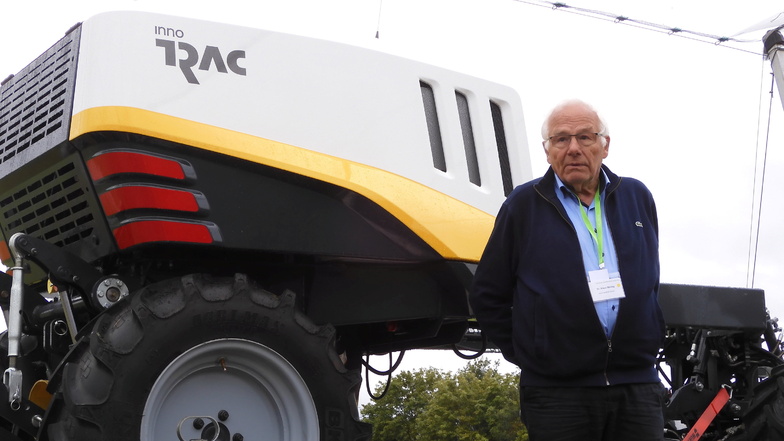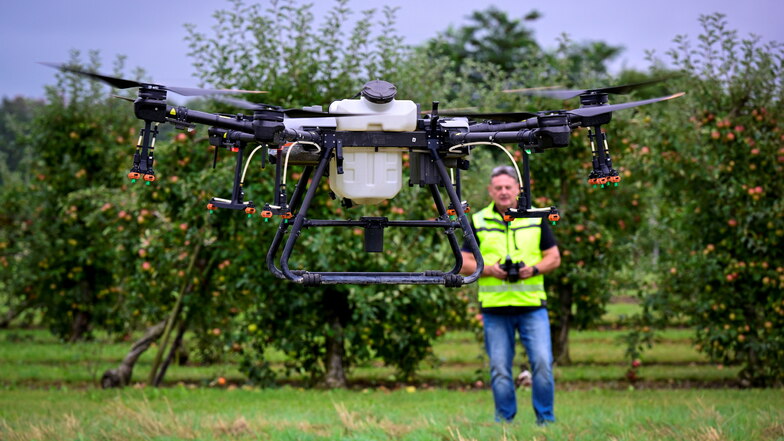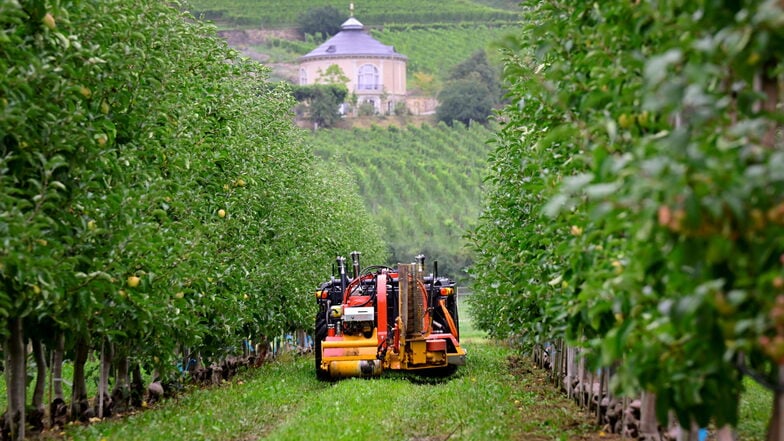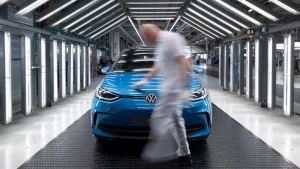From George Moeritz
Dresden. The Elwobot copes perfectly with the dead-straight rows of apple trees. The Saxon agricultural machine speeds off on wide tires, lowers the mower deck and cuts the weeds in the tramlines of the espalier orchard. At the end of the row of trees, the Elwobot turns on its own and works its way through the next one. When the electric battery is almost empty, the machine drives onto a vehicle trailer and presses its connector against a metal plate to recharge.
To teach the Elwobot so much independence, many Dresden researchers had to experiment for years. After all, the agricultural machine is supposed to do more than a standard garden mowing robot. But can the Saxon invention also pick apples - or even the pressure-sensitive strawberries? At a field day in Dresden-Pillnitz this week, fruit and wine growers were shown the latest machines and expressed their wishes to the technicians.
The Elwobot is still a research project, paid for by the state of Saxony and developed by the Technical University of Dresden and the State Agency for Environment, Agriculture and Geology (LfULG). The robot can already navigate independently because its laser sensors scan the environment. The data is transmitted via 5G mobile communications to a mobile control station and back. The Elwobot also uses satellite data and cameras.
Breakdown: hornets occupy the mobile phone container
A lidar sensor determines how densely the tree is covered with foliage at different heights while the machine is in motion. It is then possible to calculate how much crop protection agent needs to be sprayed. However, targeted spraying from different nozzles still needs to be tested. In addition, the Saxon self-propelled sprayer has so far only known standardized trial areas. Scientist Jens Fehrmann from the Chair of Agrosystems Technology prefers to speak "of automated rather than autonomous driving. We have become cautious." Much of the development work has to do with software.
Norbert Eichkorn has high hopes for robots. At the Field Day, the outgoing president of the Agricultural Office reminded the audience of the goal of halving the use of artificial pesticides in the EU by 2030. Technology is contributing to this, he said. The shortage of labor is a challenge for food production in Saxony - rationalization can help.
First of all, wild animals put the brakes on the showcase project in Pillnitz: hornets have nested in a container that provides mobile communications for the local campus network. To protect visitors, the university's communications engineers prefer to drive up another container with wifi and 5G routers.
Roller hoe on the robot instead of pesticide
Rain makes the demonstration on this Tuesday even more difficult, as there is normally no mowing or mulching. Dr. Klaus Weidig therefore doesn't even get his Caesar off the trailer, but just shows it off: Similar to the Elwobot research robot, the Caesar is a fairly autonomously driving "equipment carrier without a fixed operating station". Not only can processing equipment be connected at the front and rear, but also at the intermediate axle. Weidig recommends, for example, the rotary hoe for weed removal - instead of the chemical glyphosate.

The Caesar is a joint project of four smaller companies from the Singwitz area near Bautzen, where combine harvesters were manufactured in the GDR. Their joint company Innotrac2020 GmbH offers the Caesar not only for tillage but also for "contour cutting" on espalier fruit. Managing director Weidig does not yet want to comment on the price; after all, only one Caesar has been sold - to a Fraunhofer Institute for further research. But Weidig says the machine could probably save 80 percent of the labor costs of an operator - who would only have to prepare the machine and fill it with diesel. With the Elwobot, meanwhile, researchers are also experimenting with hydrogen charging technology.
Gripper with silicone and carbon
But the designers have not yet dared to pick fruit. Dr. Markus Henke, founder of PowerOn GmbH in Dresden, has been working on artificial muscles and sentient skin for industry for more than ten years. He demonstrates soft silicone with printed carbon veins, a deformable electronic.
Grippers with this material can, for example, transfer quail eggs and test tubes without squeezing them. Henke is offering his invention to the food industry and is still looking for users. He knows: Picking fruit is one of the most difficult tasks in automation. Before that, technicians should first try thinning it out.
In any case, Enrico Neumann advises against robots touching strawberries - even with silicone pads. The product manager of the IAV GmbH Ingenieurgesellschaft Auto und Verkehr is currently testing a robotic arm with a camera that actually harvests strawberries. But it doesn't touch the flesh of the fruit: rather, the machine must detect the stem and cut through it. "We weigh each fruit and then place it in the container".
Automotive experts now tinkering with strawberry picker
What sounds so simple, has many obstacles: Leaves, blossoms and green fruits hang in front of the ripe strawberries. The gripper has to get past them without causing any damage. For humans with two eyes and ten fingers, that's easy; for the robot, it's uncharted territory. According to Neumann, at times 40 engineers were working on the device simultaneously. This is a new task for IAV, a company that traditionally conducts research for the automotive industry in places like Stolberg and is looking for additional fields of research because of the industry's transformation.

Fruit grower Jörg Geithel wants to know from the tinkerer whether the harvest grapple also works in the open field and what quantity it can manage. After all, Geithel is chairman of the Saxon Fruit Association and also works as a fruit-growing consultant. But he won't be hearing any automatic shears snipping away in Saxon fields any time soon: IAV's experts recommend their strawberry harvester only for use on shelves in greenhouses. The test is underway in Rövershagen near Rostock.
Geithel, a practitioner, has already thought about this: "It will be a while before robots can thin or pick fruit," says the head of the Saxon association. Driving machines have been invented, but: "We lack the right tools."
So the fruit grower first looks around at the drones, which will also be presented at the field day. "I could imagine them in fruit growing," says Geithel. With the camera, the fliers could help monitor the stands at an early stage and detect damage - especially discoloration of the leaves. "The more precisely I can then carry out plant protection," he says.
Drones are prohibited in fruit growing
Spraying orchards with pesticides from a helicopter was common practice in the GDR, says Geithel. Today, aircraft are banned for crop protection in orchards - only over steep vineyards and forestry are they allowed to drop what Ulrich G. Hennig calls "spray broth." Hennig is managing director of Drones Team Chemnitz, and what he lets fly is no toy. His drone, which can maneuver a 30-liter container, is almost three meters in diameter.

The drone hovers slowly over the field at a height of just a few meters and pushes the spray down with its rotors. In front of an audience, Hennig only releases water, but this spring the Chemnitz native has already sprayed vines for the Wackerbarth State Winery and at the Cat Steps in Meissen. On the Mosel and Ahr, small aircraft with crop protection agents are in use.
However, anyone who wants to spray antifungal poison with an aircraft such as a drone must obtain a permit and warn hikers with signs. René Pfüller, a plant protection expert at the agricultural office, explains the formalities: The vintner or cooperative must explain exactly what it intends to do and also name the drone operator. The application must also justify the "need for control." "Pfüller gives his listeners a tip: "The reason is to make work easier.
Jürgen Zuschke, Chairman of the Saxon Winegrowers' Cooperative in Meissen, thinks that making work easier is basically a good thing. Walking with a backpack or hose sprayer over steep slopes and terraces is tedious, and the drone flight would help. However, Zuschke finds the requirement to register a spraying plan with the authorities in good time problematic. Flexible use is necessary, he says. Because whether in the orchard or in the vineyard, the robot must know: "Nature does what it wants."








